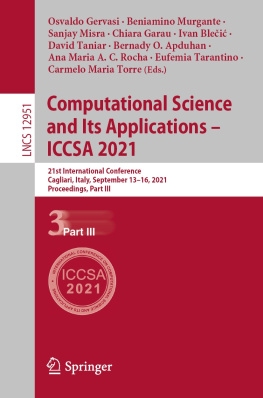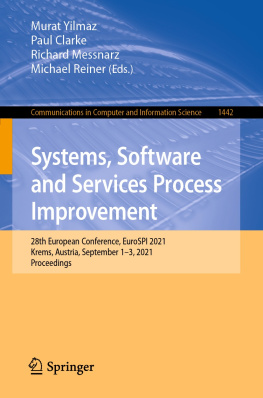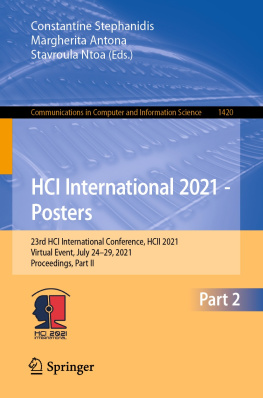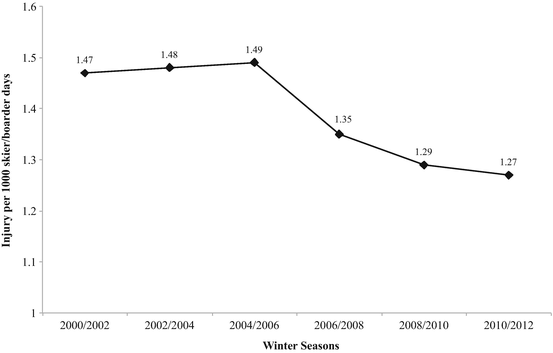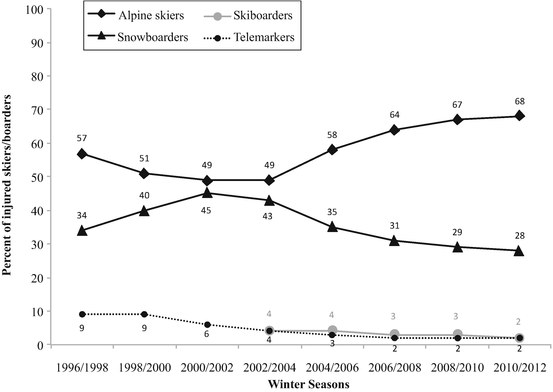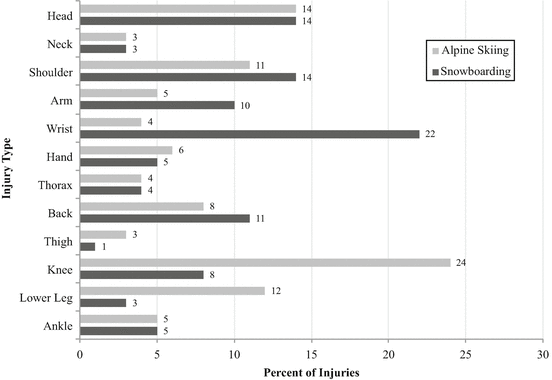Abstract
Introduction: The Norwegian Ski Lift Association has since 1996 conducted a central registration of the injuries occurring in the major Norwegian ski resorts to survey the injury types. The aim of this study was to report injury trends in the period 19962012.
Material and methods: The injuries occurring in 716 Norwegian ski resorts were recorded by ski patrols during the 16 winter seasons 1996/19972011/2012 and related to a series of demographic factors. The number of skiing/boarder days was calculated from sold lift tickets (day cards), but these were only centrally recorded from the 2000/2001 season.
Results: A total of 55127 injured skiers and boarders were recorded. The injury rate dropped from 1.47 to 1.27 injuries per 1000 skier/boarder days ( P < 0.001), and the skiing/boarding ability increased ( P < 0.001) in the period 20002012. Most of the injuries occurred on groomed slopes, but an increasing number of injuries occurred in terrain parks, from only 4% in the 2000/2002 seasons to 24% in the last two seasons. More serious injuries (fractures and back injuries) were recorded in terrain parks than those occurring at other locations. Many of the injuries were similarly distributed among skiers and boarders, but alpine skiers suffered more lower extremity injuries, especially knee injuries (24%) compared to snowboarders (7%), whereas the reverse was observed for wrist injuries with 22% for snowboarders and 5% for alpine skiers in the last 2-year period ( P < 0.001). The prevalence of knee injuries among alpine skiers has been about 25% in the period 19962012, but wrist injuries among snowboarders dropped from 29 to 22% ( P < 0.001). The prevalence of knee injuries was twice as high for females (31%) as for males (15%), whereas the reverse was observed for shoulder injuries with 19% for males and 7% for females in the last 2-year period ( P < 0.001). These differences have been observed during the whole period. Lower leg fracture for alpine skiers <13 years dropped from 20 to 13% in the period ( P < 0.001), but has remained unchanged with about 4% for teenagers and adult skiers. Helmet use by injured skiers/boarders has increased from 11 to 81% in the period, and the prevalence of head injuries has dropped from 19 to 16% ( P < 0.001).
Conclusion: The injury rate on Norwegian slopes dropped with 14% in the period 20002012. The prevalence of back injuries for injured snowboarders increased by 100% from 1996 to 2012, and this may be related to one-third of the injuries occurred in terrain parks at the end of the period. The prevalence of lower leg fracture in alpine children is declined by 35% in the period. Use of helmet by injured skiers/boarders increased from 11 to 81% and the prevalence of head injuries dropped with 16% during the same period.
Introduction
Skiing has been a popular sport in the Nordic countries for more than a century [].
The Norwegian Ski Lift Association has a central registry of the injuries occurring at the major Norwegian ski resorts since the season 1996/1997 []. The purpose of this study is to report the injury trends of skiing and boarding on Norwegian slopes in the 16-year period 1996/972011/12.
Material and Methods
The injuries occurring on the slopes of 716 major Norwegian ski resorts were recorded by ski patrols during the 16 winter seasons 1996/19972011/2012. These slopes accounted for about 50% of the ski lift transport in Norway during the registration period. A skiing/boarding injury was defined as an injury sustained by a skier/boarder who was treated by or consulted the ski patrol after a skiing/boarding accident.
The injuries were related to the type of skiing/boarding, the type and site of accident, age, and gender, skiing/boarding ability, use of protective helmet, physician or hospital treatment, and ambulance transport. Regarding skiing ability, the alpine skiers were classified by their performance of turns: expert (short turns), advanced skiers (parallel turns), intermediate skiers (stem turns), and beginners (plow turns) []. The skill of snowboarders, telemarkers, and skiboarders was self-estimated. The number of skier/boarder days was calculated from sold lift tickets (day cards and season cards). The number of day cards was only recorded from the 2000/2001 season and onwards.
The results are presented as injury rates (number of injured skiers/boarders) per 1000 skier/boarder days, mean days between injuries (MDBI), and prevalences (percentage of injured skiers and boarders in various groups). Differences were evaluated by Chi square and 2 2-table tests and considered significant when P < 0.05.
Results
3.1 Injury-Related Factors
Injury rates A total of 55127 injured skiers and boarders were recorded. The injury rate declined from 1.47 injuries per 1000 skier/boarder days (680 MDBI) in the 2000/2002 seasons to 1.27 injuries per 1000 skier/boarder days (787 MDBI) ( P < 0.001) in the 2010/2012 seasons (Fig. ). Fifty-six percent of the injuries required physician or hospital treatment and 15% ambulance transport.
Fig. 1
Injury rates (incidences) for skiers/boarders the seasons 2000/20022010/2012. n = number of injured skiers/boarders. The population at risk is based on the number of sold day cards for skiers and boarders
More than half of the injuries occurred during alpine skiing. Snowboarding peaked with 45% of the injuries in the two seasons 2000/2002, declining to 28% of the injuries during the last two seasons. Telemarking injuries dropped from 9 to 2% and skiboarding injuries from 4 to 2% of all injuries in the period (Fig. ).
Fig. 2
Prevalences of injured skiers/boarders as percentage of all injured on the slopes the seasons 1996/19972010/2012. n = number of injured skiers/boarders
Location and type of injury Many of the injuries were similarly distributed among skiers and boarders, but alpine skiers suffered more lower extremity injuries, especially knee injuries (24%) compared to snowboarders (7%) ( P < 0.001), whereas the reverse was observed for wrist injuries with 22% for snowboarders and 5% for alpine skiers ( P < 0.001) in the last 2-year period (Fig. ). Lower leg fracture was 5.6% for alpine skiers compared to 0.7% for snowboarders ( P < 0.001) in the 2010/2012 seasons, and this difference has been almost unchanged in the 16-year period. Hand injuries among alpine skiers dropped from 11 to 6% ( P < 0.001) in the same period (data not shown).








